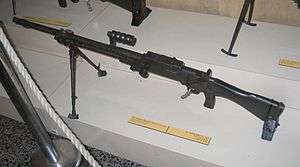Vickers–Berthier
| Vickers–Berthier | |
|---|---|
 | |
| Type | Light machine gun |
| Place of origin | France/United Kingdom |
| Service history | |
| Used by | See users |
| Wars |
Chaco War Spanish Civil War World War II |
| Production history | |
| Manufacturer | Vickers-Armstrong, Rifle Factory Ishapore |
| Produced | 1933-1942[1] |
| Specifications | |
| Weight | 24.4 lb (11.1 kg) |
| Length | 45.5 in (1.156 m) |
|
| |
| Calibre | .303 British, 7.65×53mm Mauser |
| Action | Gas-operated, tilting breech-block |
| Rate of fire | 450-600 round/min |
| Muzzle velocity | 2,450 ft/s (745 m/s) |
| Feed system | box 30 rounds |
| Sights | Iron |
The Vickers–Berthier (VB) is a British light machine gun produced by Vickers-Armstrong. It was adopted by British Indian Army and saw combat during World War II.
History
Berthier machine gun
The Vickers–Berthier was based on a French design of just before World War I. It was proposed for use with infantry as Fusil Mitrailleur Berthier Modèle 1910, Modèle 1911, Modèle 1912, Modèle 1916 and Modèle 1920.[2] It was also proposed in 1918 to US Army which finally refused it.[3]
Vickers-Berthier machine gun
In 1925 Vickers in Britain purchased licence rights of the Fusil Mitrailleur Berthier Modèle 1922[4] for production in their Crayford factory, and as a replacement for the Lewis Gun. It was an alternative to the water-cooled Vickers machine gun of same manufacture.[5] The weapon used a similar gas and tipping bolt mechanism to the Bren gun, and also had a removable barrel, and was air-cooled like the Bren. It was adopted by the Indian Army in 1933.[6] During the British Army trials of several light machine guns which began in 1932, the Vickers–Berthier was in direct competition with the ZB vz. 26. The British Army adopted the latter, modified as Bren light machine gun, and the Vickers–Berthier was adopted by the British Indian Army.[7] A production line for the Vickers–Berthier Light Machine-Gun Mk 3 was established at the Rifle Factory Ishapore.[8]
Appearance and Design
The Vickers–Berthier Light Machine Gun has a 30-round box magazine and a bipod stand, and is sometimes mistaken for the Bren as both used a similar curved magazine to accommodate the rimmed .303 British cartridge.[8]
It was slightly heavier, at 24 pounds, than the Bren at 22 pounds. It was also slightly longer, and harder to stow away. The Vickers-Berthier also had a slower cyclic rate of 500 rpm.[9] The only major advantage the weapon had over the Bren was the far simpler design; it could be produced more efficiently.[7]
It existed in five versions : Mk I, Mk II, Mk II light, Mk III and Mk IIIB.[10] Mark 1 was introduced in 1928, Mark 2 in 1931 and Mark 3 in 1933.[11]
Use
Apart from India, it was only sold to Latvia and Bolivia[12], but the design was modified into the Vickers K machine gun, called the Vickers Gas Operated (VGO).[8]
In Indian service, it was replaced from 1942 by Brens[13] but continued to serve with reserve units of Indian Army by 1998.[8]
Users




.svg.png)
.svg.png)

Failed bids


References
- ↑ Grant 2013, p. 22.
- ↑ Lorain, Pierre (July 1980). "Le Fusil Mitrailleur Berthier (1)". La gazette des armes. No. 84.
- ↑ Willbanks, James H. (2004). Machine Guns: An Illustrated History of Their Impact. ABC-CLIO. p. 96. ISBN 978-1-85109-480-6.
- ↑ Lorain, Pierre (September 1980). "Le Fusil Mitrailleur Berthier (2)". La gazette des armes. No. 85.
- ↑ "Vickers LMG". Forgotten Weapons.com.
- ↑ Grant 2013, p. 12.
- 1 2 Grant 2013, p. 10.
- 1 2 3 4 5 6 Bishop 1998, p. 245.
- ↑ Grant 2013, p. 14.
- ↑ Davie, Don. "Vickers-Berthier and VGO Machine Guns". acant.org.au. Retrieved 5 July 2018.
- ↑ Popenker, Maxim. "Vickers-Berthier". modernfirearms.net. Retrieved 5 July 2018.
- ↑ Grant J 2018, p. 76.
- ↑ Grant 2013, p. 45&48.
- 1 2 3 Alejandro de Quesada (20 November 2011). The Chaco War 1932-35: South America's greatest modern conflict. Osprey Publishing. p. 24. ISBN 978-1-84908-901-2.
- ↑ Drēziņš, Artis (9 November 2012). "Latvijas valsts armija gadu griežos". la.lv (in Latvian). Retrieved 7 August 2016.
- 1 2 Davie, Don. "More on the Vickers-Berthier". acant.org.au. Retrieved 5 July 2018.
- ↑ Grant J 2018, p. 90.
- ↑ Grant J 2018, p. 62.
Bibliography
- Grant, Neil (2013). The Bren Gun. Weapon 22. Osprey Publishing. ISBN 978-1782000822.
- Bishop, Chris (1998). The Encyclopedia of Weapons of World War II. New York: MetroBooks. ISBN 1-58663-762-2.
- Grant, Jonathan A (2018). Between Depression and Disarmament: The International Armaments Business, 1919–1939. Cambridge University Press. doi:10.1017/9781108552721. ISBN 9781108428354.
External links
- "Rifle-Machine Gun Increases Efficiency of Infantry" Popular Mechanics, December 1930 early article with photos of first Vickers–Berthier
- Berthier's patents for twin machine guns : US 1446635, FR 515677, GB 143529